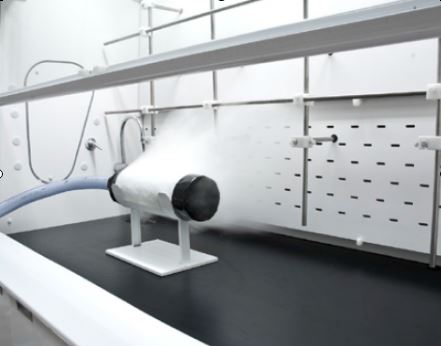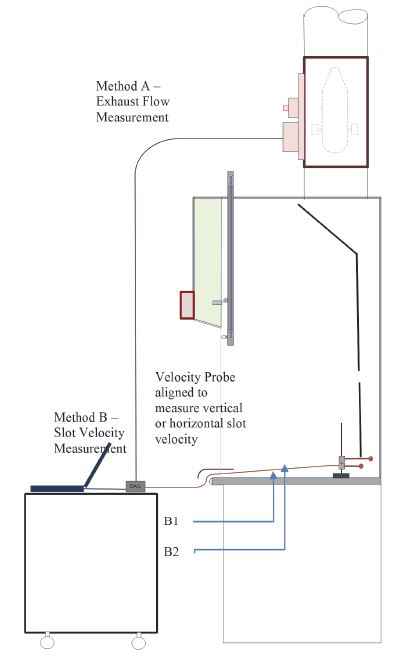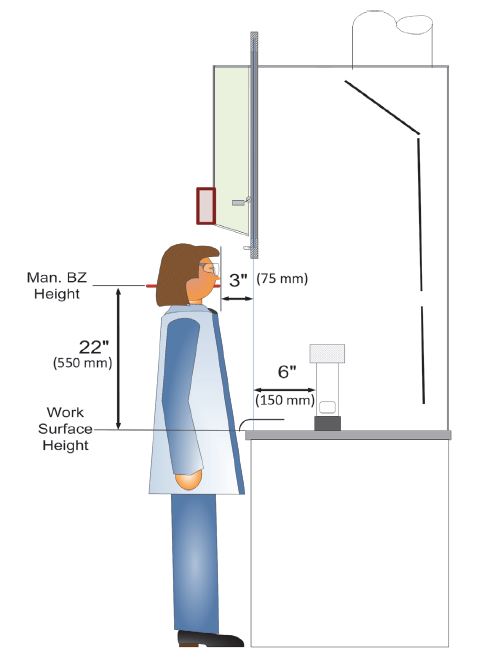Fume hoods are essential laboratory equipment that provide user protection against chemical hazards and toxic substances. The Occupational Safety and Health Administration (OSHA) states that engineering controls, such as fume hoods, must be the primary means used to reduce employee exposure to toxic chemicals. As operator safety is of importance, there is a need for fume hood performance tests to assure that fume hoods carry out their main function. One such method is through ASHRAE Standard 110.
ASHRAE Standard 110
Since its first publication in 1985 and latest revision in 2016, ASHRAE Standard 110 has provided effective methods in testing the performance of laboratory fume hoods. It is composed of three tests – flow visualization, face velocity measurements, and tracer gas containment. This series of tests quantitatively measures a hood’s containment ability, making it useful for hood development and rigorous evaluation of hood performance. Depending on test conditions, there are also three alternate ratings that can be determined: a) as manufactured (AM) test, which tests hood design at the manufacturer’s location b) as installed (AI) test, which determines whether the laboratory environment influences hood performance upon installation at the actual laboratory site, and c) as used (AU) test, which takes into account hood performance as it is typically operated.
ASHRAE 110-2016 Performance Tests
Flow visualization
Airflow visualization uses visible smoke to give a qualitative assessment of air pattern inside the hood. It is carried out through local generation and large-volume generation of smoke. Under ideal conditions, the smoke should flow smoothly towards the slots in the rear baffle.

Figure 1. Airflow visualization on Esco Frontier Acela
Face Velocity Test
The face velocity test determines the level of face velocity at a number of sampling points across the hood face. ASHRAE 110-2016 requires the use of thermal anemometers, as well as a rigorous sampling method to accurately measure instantaneous velocity. Esco uses air velocity transducer, a device which can integrate the readings for a stipulated period of time, to avoid instantaneous velocity errors common in hand held anemometers.
Table 1. Comparison between 2016 and 1995 versions of ASHRAE 110 Standard
| |
ASHRAE 110-1995 |
ASHRAE 110-2016 |
| Measuring Instrument |
Mechanical/ Electrical Anemometer |
Thermal Anemometer |
| Velocity Range |
50-400 fpm |
30-400 fpm |
| Required Accuracy Range |
± 5% of reading |
± 3% of reading or ±3 fpm (0.15 m/s), whichever is greater |
| Grid Pattern Size |
1.0 ft2 (300mm x 300mm) |
<1.0 ft2 with larger size grid rectangle not less than 330mm |
| Sampling method |
Minimum of 4 reading per point |
20 velocity readings, taken at the rate of one per second, at the center of each grid rectangle |
For face velocity tests of hoods with VAV (Variable Air Volume) systems, velocity readings are carried out at three positions of sash opening: 25% sash open, 50% sash open and full sash open. The average face velocities for all sash positions shall then be compared with design specifications.
Another test called VAV Response Test is also done to measure the efficiency of VAV controllers in response to sash movement. VAV controllers modify the hood exhaust rate to achieve a constant face velocity even at varying sash heights. The recent revision introduces two methods to conduct the said test — by measuring either the exhaust flow or the hood slot velocity. Use of data loggers are also encouraged to measure whether the controller modifies the hood exhaust rate and whether there is a change in hood performance.

Figure 2. VAV Response Test Method.
Tracer Gas Containment Test
The tracer gas test defines the ability of a fume hood to contain chemical fumes and provide user protection. It involves the release of a tracer gas SF6 to test for gas leakage along the user’s breathing zone. A gas ejector is placed 6 inches from the hood face and tracer gas is released at 4 Lpm. A mannequin containing a detector device, with a recently updated minimum detection range of 0.01 ppm – 20 ppm, is placed at the hood front. The detector probe, now inserted into the mannequin’s head, is located 22 inches above the hood’s work surface and extends 0.25 inch from the mannequin’s lips. From 26 inches in the previous version, the reduced height was made to gather accurate results, a shorter mannequin moves the probe closer to the tracer gas plume generated by the ejector.

Figure 2. Mannequin and ejector positions.
To further test tracer gas leakage, a peripheral test and sash movement containment test are also done. The peripheral test ensures that no traces of gas leaks from the hood openings. Meanwhile, the sash movement containment test, applicable to both constant-volume and variable-air-volume systems, determines the potential for contaminant escape from the hood following sash movement.
References:
ASHRAE. (2016). Methods of Testing Performance of Laboratory Fume Hoods.
Occupational Safety and Health Administration. (2017, January). Retrieved from https://www.osha.gov/SLTC/hazardoustoxicsubstances/control.html












 Spain
Spain







 Australia
Australia China
China Europe
Europe France
France Germany
Germany Indonesia
Indonesia Korea
Korea Malaysia
Malaysia Myanmar
Myanmar North America
North America Pakistan
Pakistan Philippines
Philippines Russia
Russia Singapore
Singapore South Africa
South Africa Thailand
Thailand UK
UK Vietnam
Vietnam